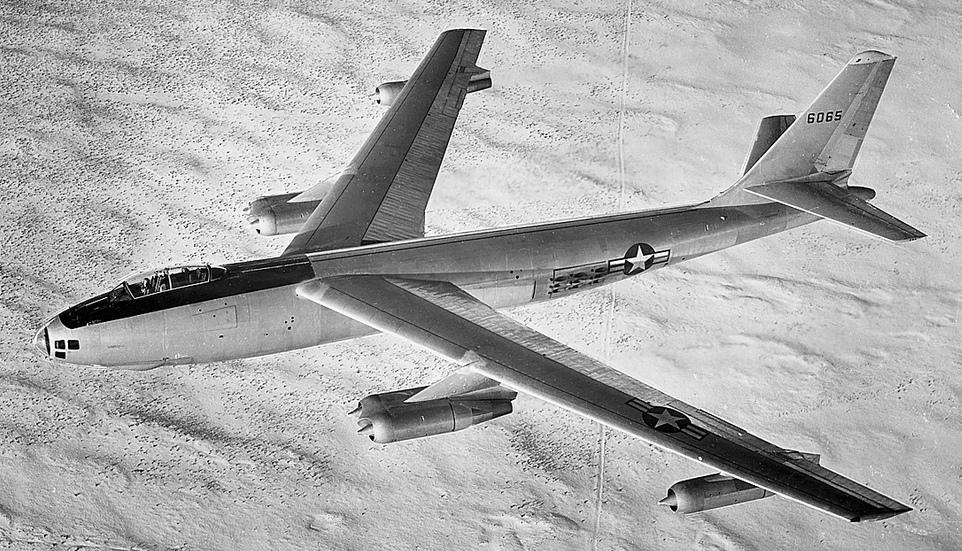
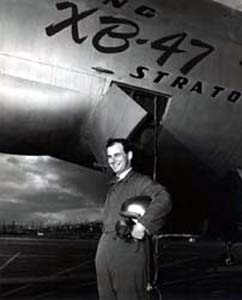
17 December 1947: Boeing test pilots Robert M. Robbins and Edward Scott Osler made the first flight of the Model 450, the XB-47 Stratojet prototype. It was a 52-minute flight from Boeing Field, Seattle, to Moses Lake Air Force Base, five miles north of the town of Moses Lake, Washington.
Robbins later said, “The best way to tell about the performance of the Stratojet is to say that any good crew could have flown it. It took no unusual ability or education. Neither Scott Osler nor I deserve any credit for the flight. Rather, the credit should go to the men who carried out these visions on the drafting boards and the factory workers who made the visions a reality.”
On 11 May 1949, during flight testing at Moses Lake, the canopy of 46-065 came off, killing test pilot Scott Osler. The co-pilot safely landed the airplane.
Designed as a strategic bomber, the B-47 could fly higher and faster than jet fighters of the time, and it was also highly maneuverable. The XB-47 (Boeing Model 450) was flown by a two-man crew in a tandem cockpit. It was 107 feet, 6 inches (32.766 meters) long with a wingspan of 116 feet (35.357 meters). The top of the vertical fin was 27 feet, 8 inches (8.433 meters) high. The wings were shoulder-mounted with the leading edges swept at 35°.
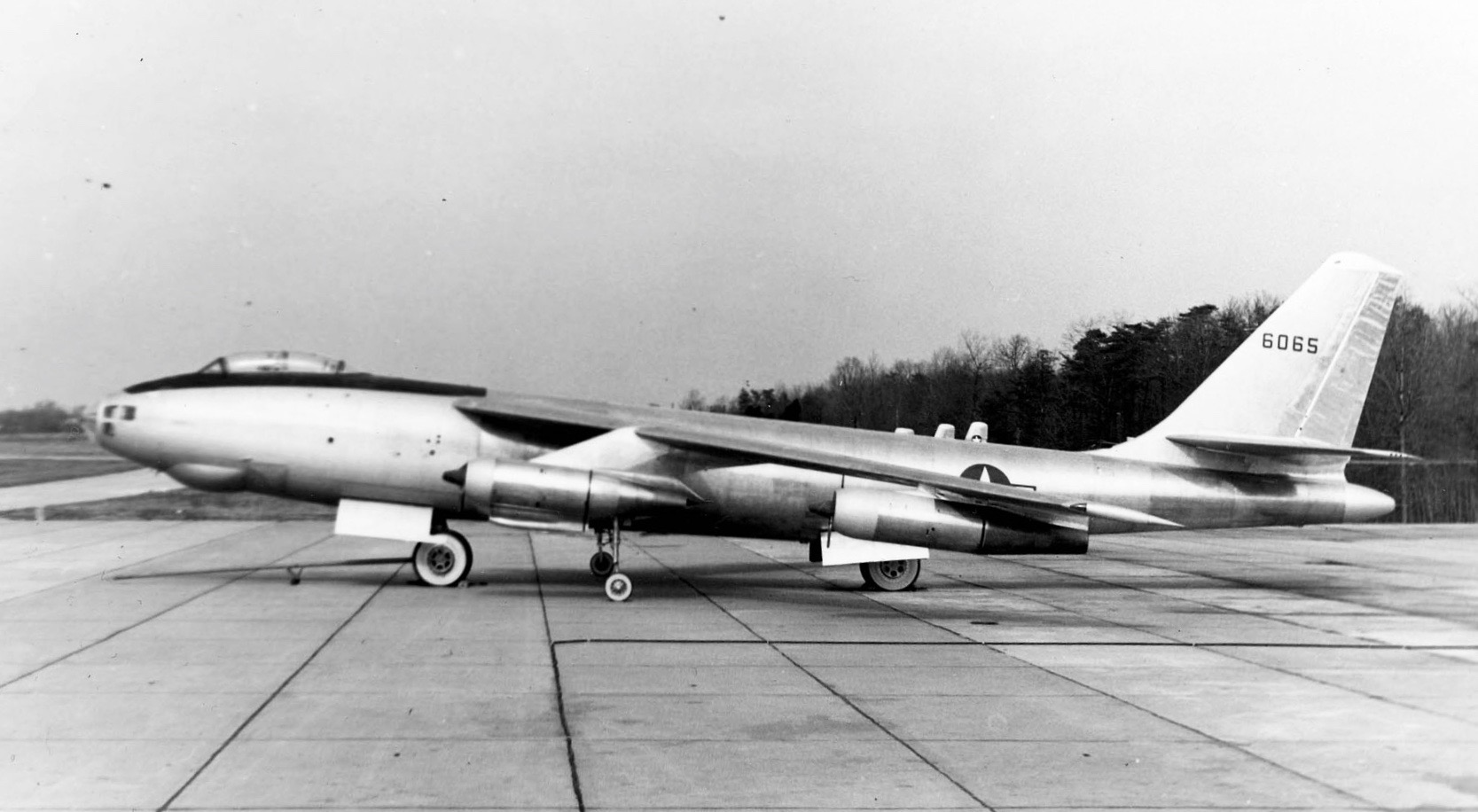
The first prototype, 46-065, was powered by six General Electric J35-GE-7 axial flow turbojet engines in four pods mounted on pylons below the wings. The J35 was a single-spool, axial-flow turbojet engine with an 11-stage compressor and single-stage turbine. The J35-GE-7 was rated at 3,750 pounds of thrust (16.68 kilonewtons) at 7,700 r.p.m. (static thrust, Sea Level). The engine was 14 feet, 0.0 inches (4.267 meters) long, 3 feet, 4.0 inches (1.016 meters) in diameter and weighed 2,400 pounds (1,089 kilograms). (The second prototype, 46-066, was completed with J47 engines. 46-065 was later retrofitted with these engines.)
The XB-47 prototype had a maximum speed of 502 knots (578 miles per hour/930 kilometers per hour/0.80 Mach) at 15,000 feet (4,572 meters). The combat speed was 462 knots (532 miles per hour/856 kilometers per hour/0.70 Mach) at 35,000 feet (10,668 meters). The prototype’s empty weight was 74,623 pounds (33,848 kilograms), while its maximum takeoff weight was 162,500 pounds (73,709 kilograms). It required a ground run of 11,900 feet (3,627 meters), or 4,800 feet (1,463 meters) with JATO assist. The bomber could climb at a rate of 3,650 feet per minute (18.5 meters per second) at Sea Level, at combat weight and maximum power. The service ceiling was 37,500 feet (11,430 meters). The XB-47 carried 9,957 gallons (37,691 liters) of fuel. The combat radius was 1,175 nautical miles (1,352 statute miles/2,176 kilometers) with a 10,000 pound (4,536 kilogram) bomb load.
Planned armament (though the XB-47s were delivered without it) consisted of two .50-caliber machine guns in a tail turret, with 1,200 rounds of ammunition, and 10,000 pounds (4,536 kilograms) of bombs.
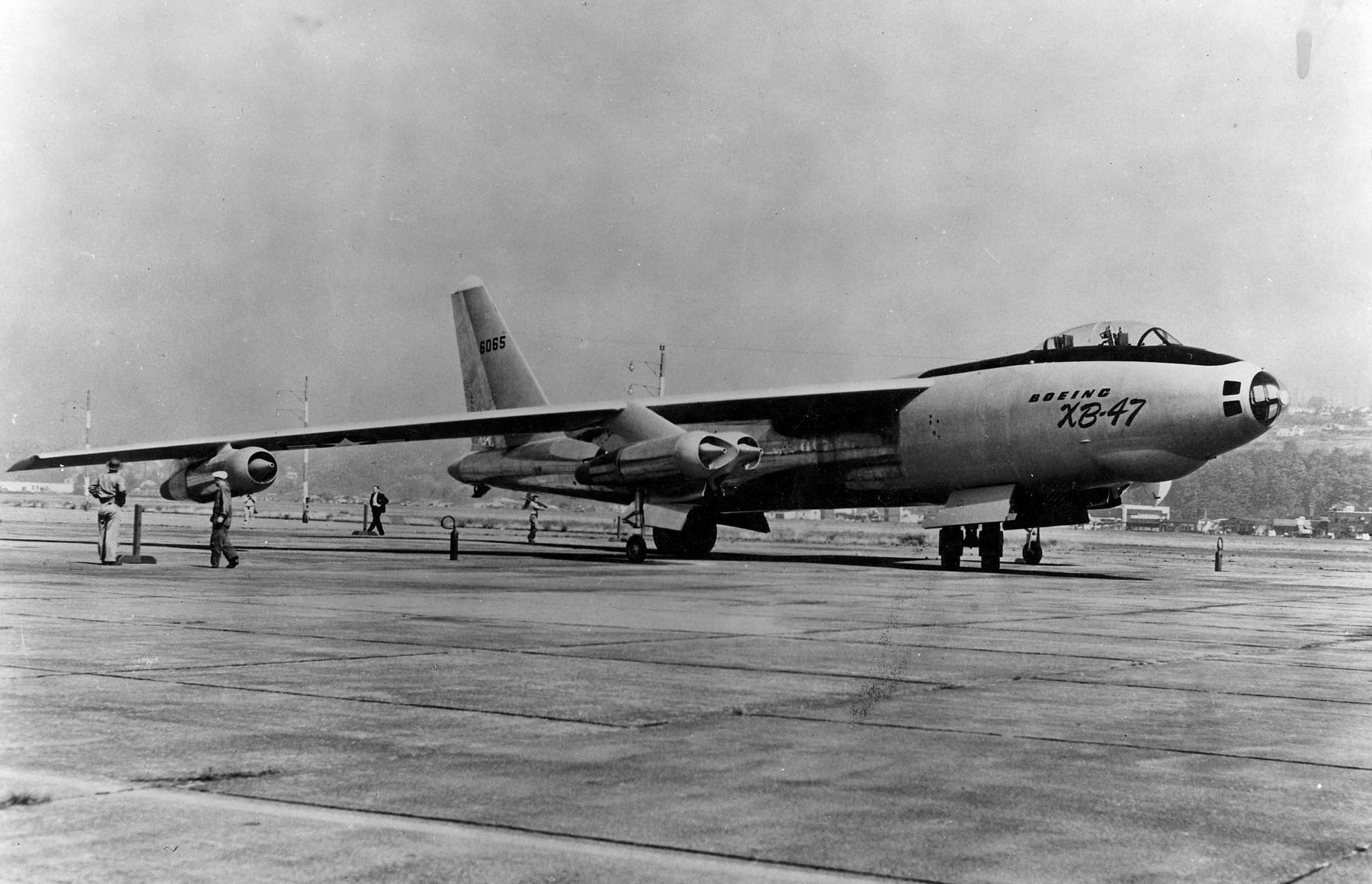
The Stratojet was one of the most influential aircraft designs of all time and its legacy can be seen in almost every jet airliner built since the 1950s: the swept wing with engines suspended on pylons, mounted forward of the leading edge.
2,032 B-47s were built by Boeing Wichita, Douglas Tulsa and Lockheed Marietta. They served the United States Air Force from 1951 to 1977.
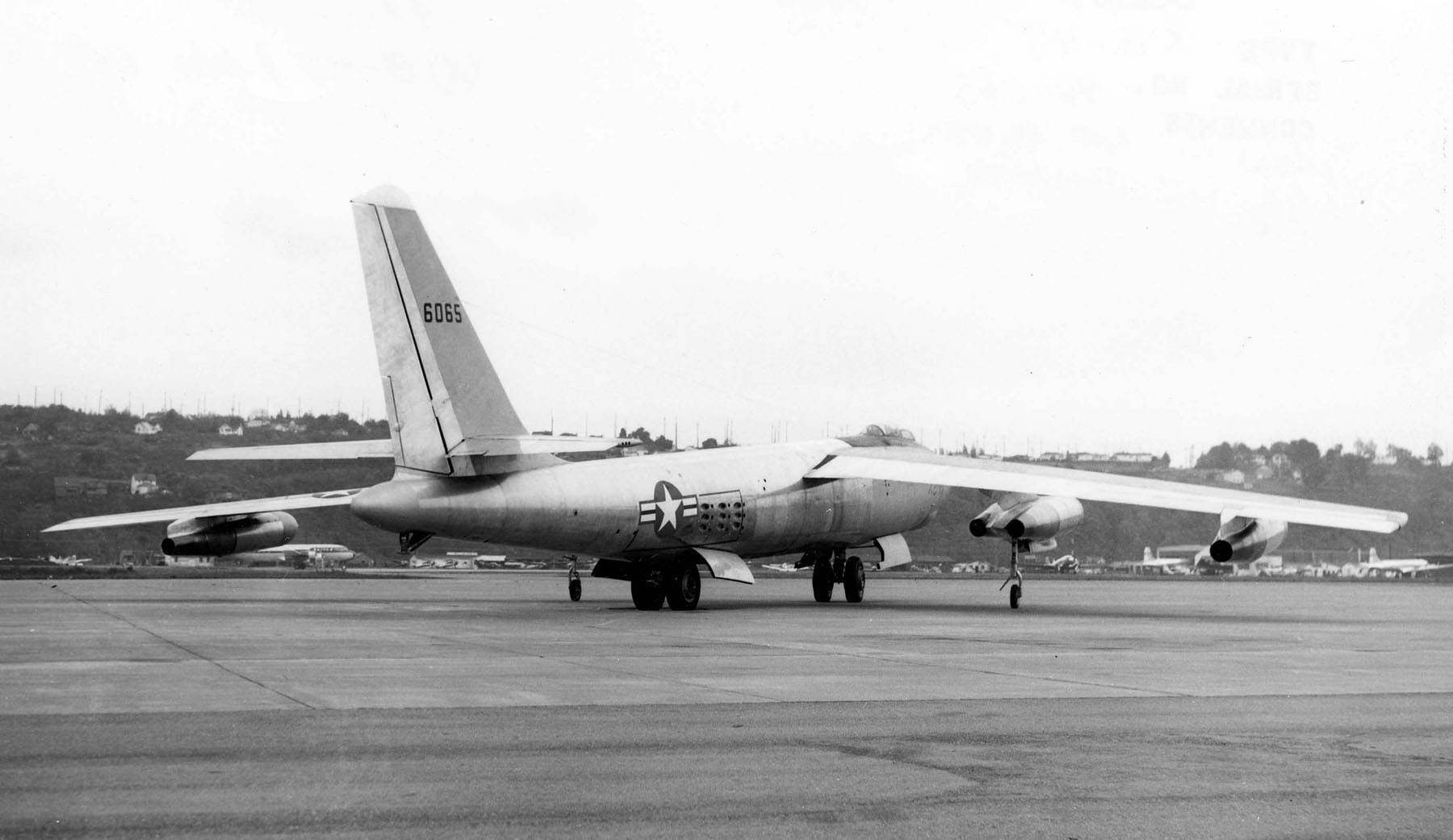
The very last B-47 flight took place 18 June 1986 when B-47E-25-DT, serial number 52-166, was flown from the Naval Air Weapons Center China Lake to Castle Air Force Base to be placed on static display.
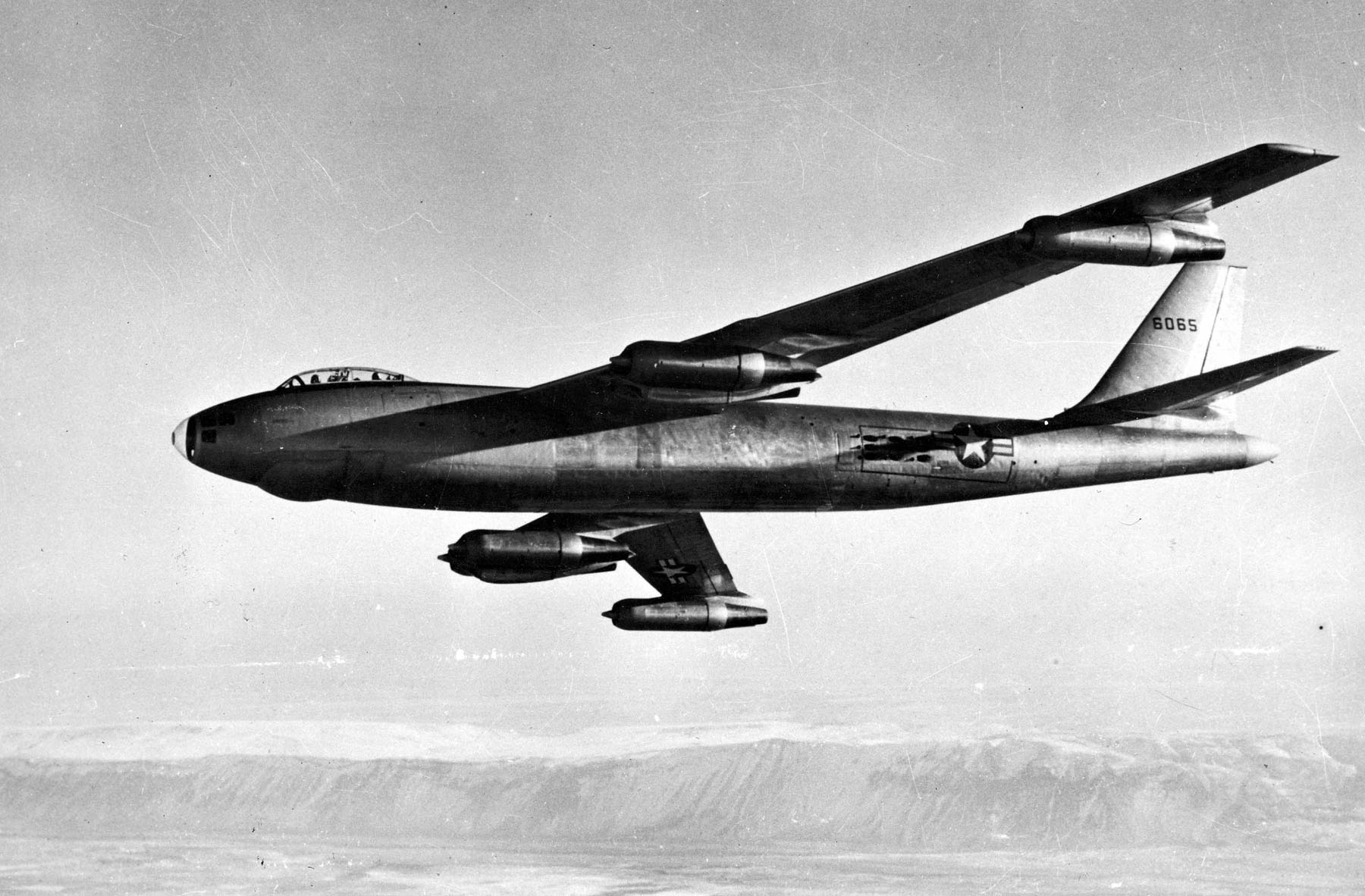
XB-47 45-065 stalled while landing at Larson Air Force Base, near Moses Lake, Washington, 18 August 1951. The crew of three escaped uninjured. The airplane suffered major structural damage. It was returned to Boeing at Seattle, Washington in 1953. The second prototype, XB-47 46-066, is in the collection of the Air Force Flight Test Museum, Edwards Air Force Base, California.
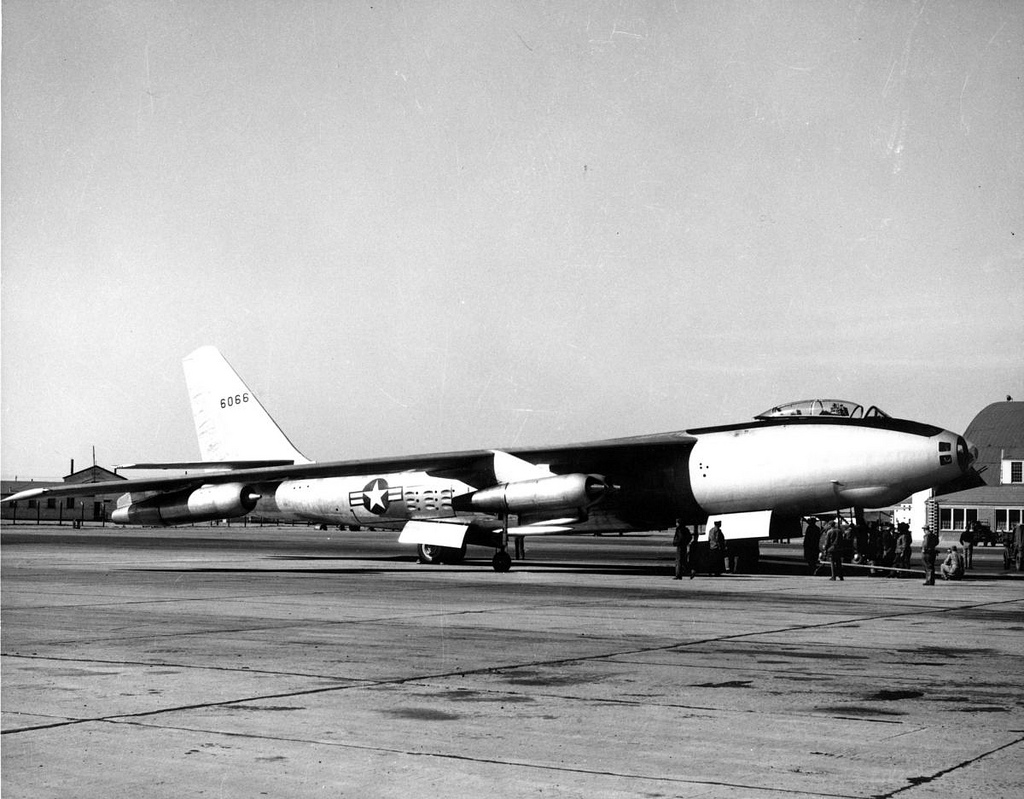
© 2017, Bryan R. Swopes
Hi Thisdayinaviation,
What happened to the original header and colours on the site?
I used to love the way it looked, with the gold letters on red.
Now the red text is almost unreadable on the black & white background.
I was just curious why it got changed,
Marcus Langendorff
Hi, Marcus. I switched to the WordPress Twenty-Thirteen “theme”. It allows larger photographs—which are much easier to upload—and most find that the text font has more greater contrast.I have been experimenting with different colors for the title, but nothing seems to work very well with the black-and-white photograph that I chose for the header. But, other than that, do you like the blog?
Thank you for your comments,
Bryan
Yeah, i love it! I have it set as my start-up page, both at home as at work. Some of my co-workers have done the same thing now. And sometimes i share photos or interesting stories on my facebook.
Keep up the good work,
Marcus
THANK YOU VERY MUCH!
ROBERT M.”BOB” ROBBINS was a friend of mine I’m proud to say.
I have photos of him, incl. looking up into the bomb bays of a B2 at Whiteman, home of the 509th.
A most gracious and humble man, post career doer of great deeds, incl. a call to Bowing Chairman and discuss rehab possibilities for B-29 FIFI, Commemorative Air Force.
He started their Florida Wing.
This man was and is deserving of the Medal of Freedom.
I had a copywrited pic enlarged, mid-air of FIFI, Bob signed off on one lower corner and Paul Tibbets on the opposite corner.
Time has taken so many that gave so much.
God speed BOB Robbins.
Fully agree. Bob was a friend and a wonderful gentleman. He inspired me to reaearch the B-47 story and write its history.
. . . and that would be Boeing B-47 Stratojet: Strategic Air Command’s Transitional Bomber, by C. Mike Habermehl & Robert S. Hopkins III.
I ONCE WATCHED FROM MY ROOM IN OUR BARRACKS AS MANY B-47’S WERE LAUNCHED ON MISSIONS OF UNKNOWN. IT WAS THE YEAR OF 1963, THE LOCATION WAS ELMENDORF AFB AT ANCHORAGE AK. THEY WERE BEAUTIFUL TO WATCH!
Thanks, Edward. It remains one of the world’s best-looking airplanes.
The XB-47 may have been manned with a crew of 2, but all others had a navigator/bombardier in the nose for a crew of 3.
Eons ago when men were men and stupid as holes flew under bridges with their B47 bombers – Life was much simpler…
great aeroplane from the team at boeing
1500 hours+_ in Bs and Es. Thank God, they stopped doing LABS (toss bombing) with them.
They were experimenting with the toss bombing
In 1957. I was Bomb-NAV Tech. Then. The B-47 was
a beautiful plane.
I was in the 305th BW when we were doing the toss bombing and we lost two B-47s, one at Eglin AFB and one at Bermuda. That was before the Milk Bottle Mods to strengthen the wings.
Grew up at Topeka, KS, home of Forbes AFB with all different versions of the B-47, including the RB-47H that the Russian pilot shot down on the first peripheral flight around Russia after Gary Power’s was shot down. Worked my way through college as a laborer and helped build readiness crew building. Later worked at installing new landing light foundations on the active runway. Nearly got run over by a TB-47 training pilot when he landed nose high, and the front landing gear and the right gear slammed down, and we were off to the left. He was headed straight for us at about 120 mph, but thankfully he or the instructor pilot got it righted and made a go around. Otherwise, we and the concrete truck would have all disappeared in a ball of fire. Does anyone know what color the “Boeing XB-47” was on the nose of the prototype? I’ve never seen a color picture of it.